Creating custom aromatherapy soap blends requires balancing top notes (20-30%), middle notes (30-50%), and base notes (20-30%). For cold process soaps, use about 0.7 oz of essential oils per pound; for hot process, use 0.3 oz per pound. Keep total essential oil content below 3% for skin safety. Consider therapeutic properties like lavender for calming, tea tree for antimicrobial benefits, and sweet orange for mood lifting. This balance of art and science reveals endless creative possibilities.
Understanding Essential Oil Notes in Aromatherapy Soap Making

When crafting your own aromatherapy soap, understanding the three distinct categories of essential oil notes becomes essential to creating balanced, therapeutic blends.
Base notes, like patchouli and cedarwood, provide the foundation of your soap's scent profile, offering longevity that remains even after washing.
Middle notes function as the heart of your blend, with oils like lavender and rosemary harmonizing the stronger elements.
Top notes—typically citrus fragrance oils such as lemon and orange—deliver that initial burst of scent that catches your attention.
Creating Balanced Blends: Top, Middle, and Base Notes
Creating balanced aromatherapy soap blends requires a thoughtful approach to combining essential oils from different note categories.
When crafting your essential oil blend, remember that top notes like lemon or peppermint provide the initial scent impression but evaporate quickly, making up 20-30% of your composition.
Middle notes form the heart of your blend, comprising 30-50% of the mixture. Oils like lavender and geranium offer longer-lasting fragrances that emerge as top notes fade.
For depth and longevity, incorporate base notes such as cedarwood or patchouli at 20-30% of your blend.
Your goal is to achieve balanced blends where each note complements the others, creating a harmonious scent experience that evolves beautifully as your customers use the soap, with initial brightness yielding to lasting complexity.
Therapeutic Properties of Common Soap Making Essential Oils
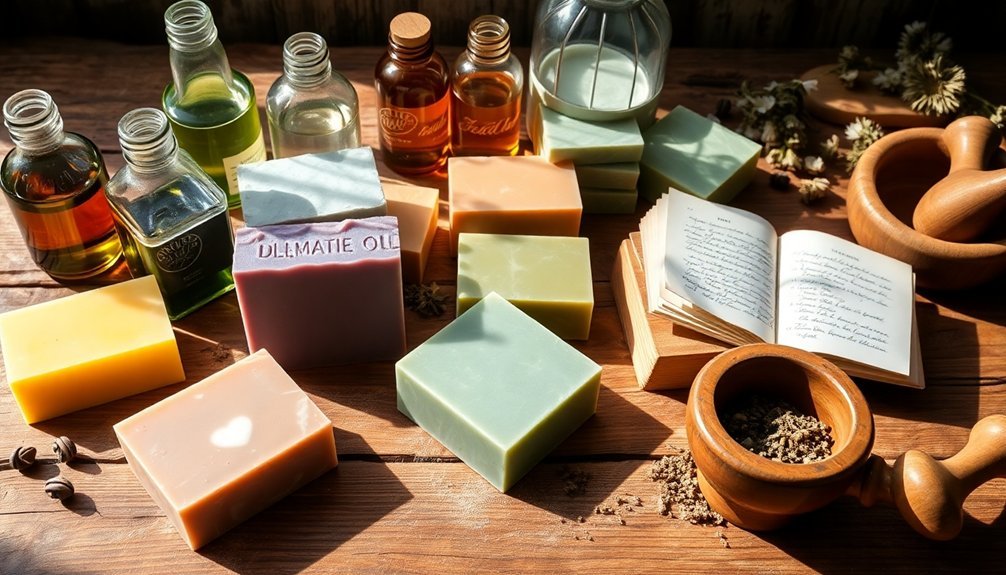
Essential oils serve as the soul of aromatherapy soap making, each bringing unique therapeutic benefits beyond just pleasant fragrances.
When selecting essential oils for soapmaking, understanding their specific properties helps you create products with targeted wellness benefits:
- Lavender offers calming properties that reduce stress and promote relaxation—perfect for evening use soaps or anxiety-relief blends.
- Tea tree delivers powerful antimicrobial qualities that combat acne and skin irritations, making it ideal for facial bars and problematic skin formulations.
- Eucalyptus provides respiratory relief and mental clarity through its invigorating scent—excellent for morning shower soaps.
- Peppermint creates a cooling sensation that alleviates headaches and improves focus, while sweet orange's mood-enhancing properties lift spirits and reduce anxiety.
Choose oils that align with your desired therapeutic outcome for truly effective aromatherapy soap blends.
Masterbatch Techniques for Consistent Essential Oil Blends
Now that you understand the therapeutic properties of individual essential oils, the next challenge lies in maintaining consistency across your soap batches. Creating masterbatches in Soapmaker 3 solves this problem efficiently.
Start by opening My Supplies and proceeding to the Blends tab. Enter your essential oil recipe twice, checking the Exclude Weight box for the second entry to account for waste. Save your blend with a descriptive name for easy identification.
For base oil masterbatches, follow the same process, then incorporate them into new soap recipes by simply entering the masterbatch name in the base oils section. This maintains accurate SAP values and fatty acid profiles.
When you click Make, Soapmaker 3 tracks your masterbatch instead of individual ingredients, ensuring consistent costs and streamlining inventory management.
Essential Oil Ratios: Calculating Perfect Proportions
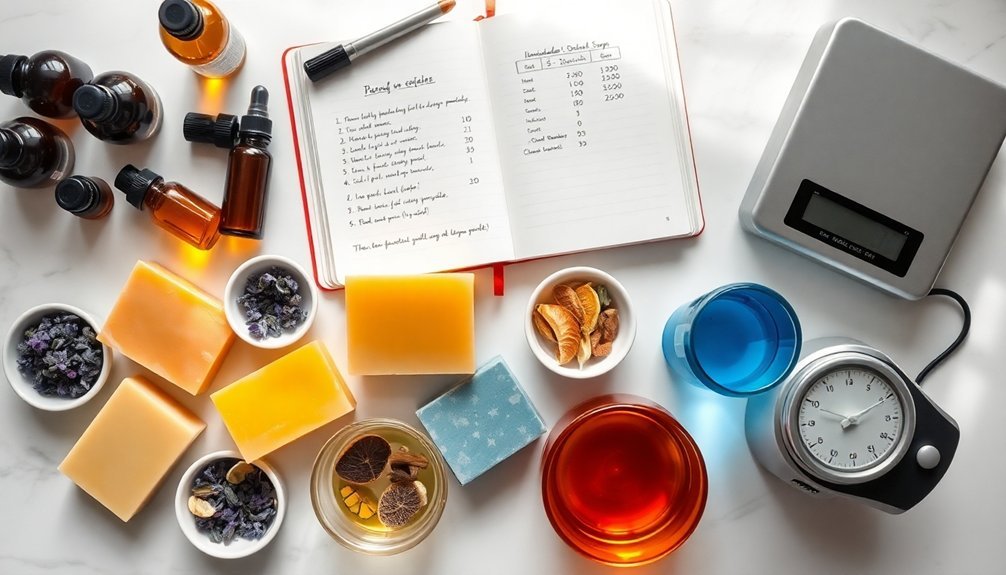
Creating perfect aromatherapy soap requires precise mathematics, with cold-process soaps needing about 0.7 ounces of essential oil per pound while hot-process uses roughly 0.3 ounces per pound.
You'll want to maintain total essential oil content below 3% of your soap's weight for skin safety, using the "parts" system to create balanced blends like 2 parts orange to 1 part vanilla.
Tracking your calculations in detailed records will help you develop consistent therapeutic formulations that achieve your desired scent strength while maintaining the proper dosage for both aromatic and therapeutic benefits.
Base-to-Essential Oil Mathematics
Mastering the mathematics of essential oil proportions forms the foundation of successful aromatherapy soap making. Understanding the precise amount of oils needed will guarantee your soaps deliver the perfect aromatic experience while maintaining quality.
- Cold-process soap requires approximately 0.7 ounces of essential oils per pound, while hot-process soap needs just 0.3 ounces per pound due to different curing methods.
- For standard batches, aim for 1 ounce of essential oils per 1.5 pounds of soap base, adjusting to your scent preference.
- Express your blend in "parts" (drops, teaspoons, or cups) to simplify calculations and maintain consistent ratios.
- Always account for oil characteristics when calculating usage rates—stronger oils require less volume to achieve the same aromatic impact in your finished soap.
Scent Strength Calculations
The perfect aromatic soap begins with precise scent strength calculations that balance potency with safety. When crafting your cold process soap recipe, you'll need to carefully measure essential oils based on your oil weight.
| Process Type | Recommended EO Ratio |
|---|---|
| Cold Process | 0.7 oz per pound |
| Hot Process | 0.3 oz per pound |
| Small Batch | 1 oz per 1.5 pounds |
| Medium Blend | 4:1 (parts) |
| Custom Blend | Varies by oil type |
For maximum scent strength that persists through curing, aim for approximately 0.7 oz of essential oils per pound in cold process methods. Hot process soap requires less—about 0.3 oz per pound—as the cooking process helps retain fragrance. Always check the maximum usage rate for each oil to guarantee your beautiful creations remain skin-safe.
Therapeutic Dosage Charts
Beyond basic scent calculations lies the art of therapeutic proportioning—where your soap transforms from merely pleasant-smelling to genuinely beneficial. Understanding essential oil dosage is vital for maximizing therapeutic properties while ensuring skin safety.
- Process-Specific Measurements: Use 0.7 oz of oils per pound for cold-process soap, but reduce to 0.3 oz per pound for hot-process varieties due to their different curing methods.
- Ratio-Based Blending: Create balanced essential oil blends using simple ratios—like the popular 1:1 Lavender-Peppermint combination—for consistent therapeutic effects.
- Flexible Proportioning: Adjust your "parts" measurement (drops, teaspoons, cups) based on your batch size while maintaining ratios.
- Safety-First Formulation: Always respect maximum usage rates for each oil, prioritizing skin safety while targeting specific therapeutic benefits like stress relief or energy.
Seasonal Aromatherapy Blends for Specialty Soap Collections
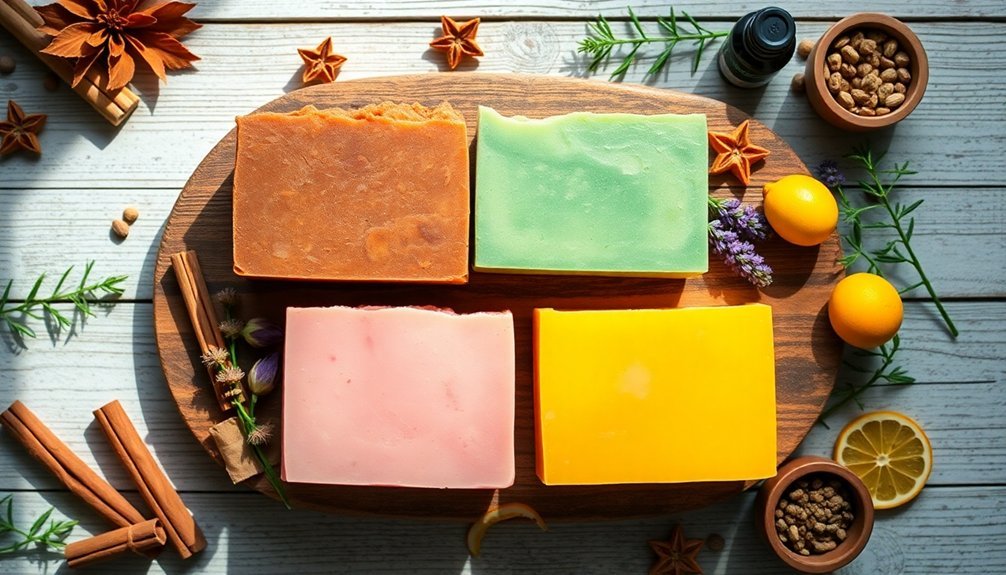
You'll boost your soap's appeal with seasonal aromatherapy blends that connect customers to nature's changing cycles.
Your seasonal scent pairing chart should match complementary oils like cinnamon with vanilla for fall or lavender with lemon for spring, creating emotionally resonant products.
Holiday mood-enhancing blends, such as peppermint with eucalyptus for winter refreshment or sweet orange with clove for festive cheer, can transform your specialty collections into must-have seasonal offerings.
Seasonal Scent Pairing Chart
Creating seasonal soap collections becomes both an art and science when you understand how essential oils pair together to evoke specific moods and experiences.
Your soap-making will transform when you match aromatic profiles to nature's calendar, delighting customers seeking seasonal products.
- Spring: Combine lavender and peppermint in a 2:1 ratio for refreshment, or pair lemon with rosemary for an invigorating clean scent.
- Summer: Blend sweet orange and peppermint for cooling uplift, or mix bergamot with lime for a tropical escape.
- Fall: Create comfort with a 3:1 ratio of clary sage to bergamot, or blend cedarwood with cinnamon for warmth.
- Winter: Pair pine with vanilla for cozy festivities, or combine cinnamon and orange for holiday cheer.
Customizing blends with local seasonal ingredients further enhances your soap's connection to each season.
Holiday Mood-Enhancing Blends
While everyday soaps serve practical purposes, holiday-themed aromatherapy blends transport users to cherished moments and festive celebrations. These special essential oils combinations offer therapeutic benefits beyond cleansing—they reduce stress during the busy season while evoking warmth and nostalgia.
| Blend Name | Formula for Gift-Giving |
|---|---|
| Winter Hearth | 2 parts sweet orange, 1 part cinnamon, 1 part clove |
| Christmas Forest | 3 parts pine or fir, 1 part cedarwood |
| Peppermint Cookie | 2 parts peppermint, 1 part vanilla |
| Spiced Citrus | 2 parts orange, 1 part clove, 1 part nutmeg |
Try adding these holiday mood-enhancing blends to your seasonal soap collection. The comforting aroma of cinnamon paired with orange creates an inviting atmosphere, while pine notes evoke freshly cut Christmas trees—perfect for thoughtful, handcrafted presents that delight the senses.
Synergistic Combinations: Enhancing Therapeutic Benefits
The true power of aromatherapy soap emerges when essential oils combine to create effects greater than the sum of their parts.
When crafting synergistic combinations, you'll reveal enhanced therapeutic benefits while creating balanced, complex aromas that transform your soap-making projects.
- Consider the notes hierarchy – Blend top notes like bergamot with base notes such as cedarwood for a harmonious, grounding effect that maintains balance.
- Pair for purpose – Combine lavender and eucalyptus to simultaneously promote relaxation and respiratory support.
- Boost cognitive function – Mix rosemary and peppermint for improved mental clarity and focus.
- Follow proper ratios – Use approximately 1 ounce of essential oil blend per 1.5-pound soap batch, and experiment with specific ratios (like 2:1 chamomile to ylang-ylang for anxiety relief).
Preserving Scent Integrity: Hot vs. Cold Process Methods
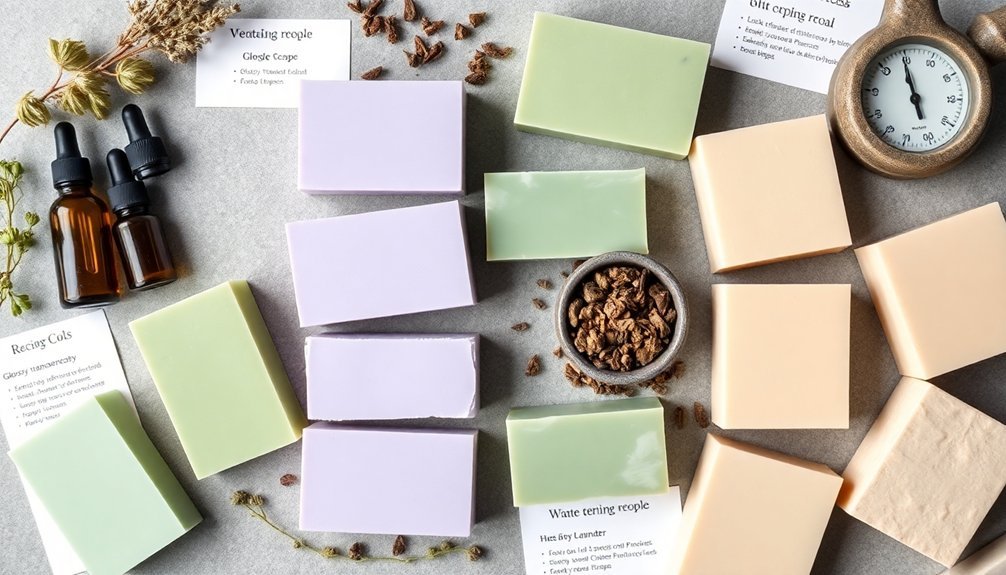
When crafting cold-process aromatherapy soaps, you'll face the challenge of essential oil dissipation, requiring about 0.7 oz. per pound to maintain scent integrity throughout the lengthy curing period.
Hot-process soapmaking offers distinct advantages for preserving fragrance, as you'll add oils after cooking when temperatures have dropped, using only 0.3 oz. per pound while achieving stronger scent retention.
You'll notice significant differences in the final aromatic profile depending on your process choice, with premium quality oils like Young Living demonstrating superior performance in both methods.
Cold Process Challenges
Crafting aromatherapy soaps through cold process methods presents unique challenges for preserving essential oil scents. During the extended curing time of 4-6 weeks, your carefully selected fragrances may diminish considerably, requiring strategic planning.
- You'll need approximately 0.7 oz of essential oils per pound of soap base—more than double what hot process requires—to compensate for scent loss during curing.
- Add your essential oils at trace, when the mixture begins to thicken, to maximize scent retention.
- Select high-quality oils like Young Living for stronger, longer-lasting fragrances that withstand the saponification process.
- Expect your scent profile to evolve and become more complex as the soap cures, making experimentation with different blends essential to achieving your desired aromatic result.
Hot Process Benefits
Three key advantages make hot process soap making superior for preserving essential oil aromas in your aromatherapy blends. When you add essential oils at the end of the hot process, you'll lock in their scent integrity far better than with cold process methods. You'll also need less oil—typically just 0.3 oz per pound of soap—saving you money while still achieving robust results.
| Hot Process Advantage | Benefit to Your Aromatherapy Soap |
|---|---|
| Late-stage oil addition | Preserves volatile compounds |
| Lower oil requirements | Cost-effective (0.3 oz/lb) |
| Enhanced temperature effect | Highlights specific fragrance notes |
| Immediate scent enjoyment | No waiting for aroma development |
| Better retention | More distinct aroma profile |
The cooking process creates an environment where your carefully selected fragrance notes can truly shine, particularly when working with citrus or herbal essential oils that often lose potency in cold process techniques.
Customizing Blends for Specific Skin Conditions
Creating effective aromatherapy soap blends requires understanding your specific skin needs and selecting appropriate essential oils to address them. When formulating custom soaps, you'll want to match therapeutic properties with your skin condition for ideal results.
- Acne-prone skin benefits from tea tree oil's antibacterial properties, while dry skin needs moisturizing carrier oils like jojoba or sweet almond at appropriate dilution rates.
- Sensitive or irritated skin responds well to lavender's soothing qualities, which can calm inflammation and redness.
- Eczema or psoriasis conditions improve with gentle additions like colloidal oatmeal or aloe vera that reduce itching and irritation.
- Always conduct a patch test before fully incorporating new essential oils into your regimen, especially if you've experienced sensitivities in the past.
Botanical Infusions: Amplifying Essential Oil Properties
While essential oils provide powerful therapeutic benefits on their own, botanical infusions can greatly enhance their properties in soap formulations. When you steep dried herbs in carrier oil, you'll extract beneficial compounds that complement your essential oils' therapeutic properties.
| Botanical | Benefits When Combined with Essential Oils |
|---|---|
| Chamomile | Enhances anti-inflammatory properties |
| Calendula | Accelerates skin healing processes |
| Lavender | Deepens relaxing aromatherapy effects |
| Rose | Amplifies moisturizing skin conditioning |
| Mint | Boosts invigorating sensory experience |
For best results, infuse your botanicals for several weeks in your chosen carrier oil. The longer steeping time yields stronger concentrations of beneficial compounds. You'll notice your finished soaps not only smell more complex but also provide enhanced skin conditioning benefits that pure essential oils alone can't deliver.
Frequently Asked Questions
What Is the 30/50/20 Rule for Essential Oils?
The 30/50/20 rule guides your essential oil blending: use 30% top notes (initial impression), 50% middle notes (harmony), and 20% base notes (depth and longevity) to create well-balanced, effective aromatherapy combinations you'll love.
What Essential Oil Blends Well Together for Soap?
You'll find several great combinations for soap: Spearmint Patchouli (4:1 ratio), Orange Vanilla (2:1), Lavender Peppermint (1:1), Man's Man blend (1:2:1 of patchouli, bergamot, cedarwood), and Orange Mint (2:1). Use about 0.7oz per pound.
What Fragrance Blends Well Together?
You'll find that citrus with vanilla, lavender with sage, and spearmint with patchouli blend beautifully together. Try pairing complex scents with simpler ones rather than mixing two elaborate fragrances that might clash.
What Essential Oils Should Not Be Used in Soap?
You shouldn't use cinnamon bark, clove, oregano, wintergreen, birch, or undiluted citrus oils like bergamot in soap. They can cause skin irritation, toxicity, or photosensitivity when applied to your skin.
In Summary
You've now got the knowledge to create your own signature aromatherapy soap blends. Remember to balance your essential oil notes, calculate proper ratios, and consider both therapeutic benefits and preservation methods. Whether you're addressing specific skin conditions or simply crafting for pleasure, your custom soaps will deliver both sensory enjoyment and wellness benefits. Trust your nose and don't be afraid to experiment—your perfect blend awaits!

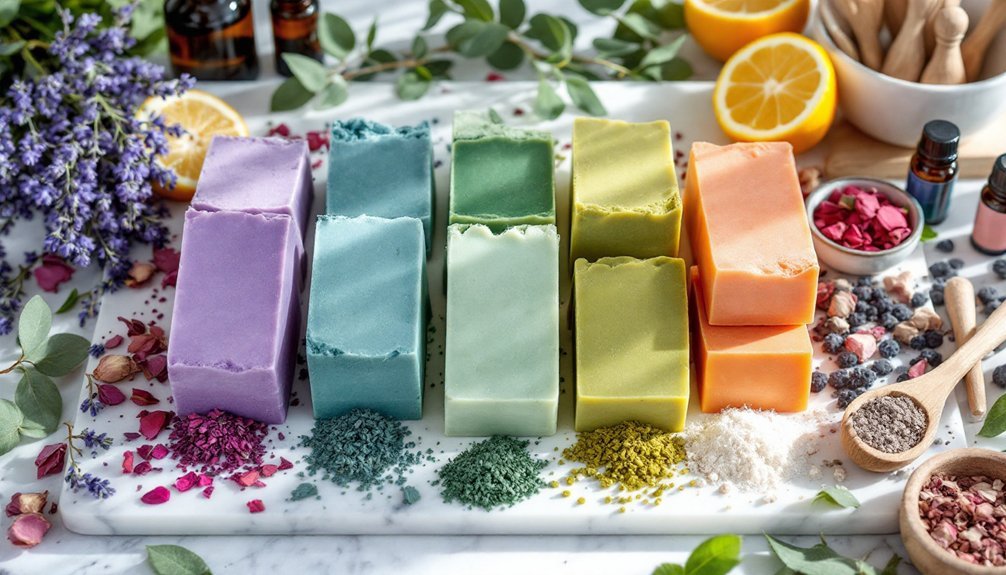



Leave a Reply